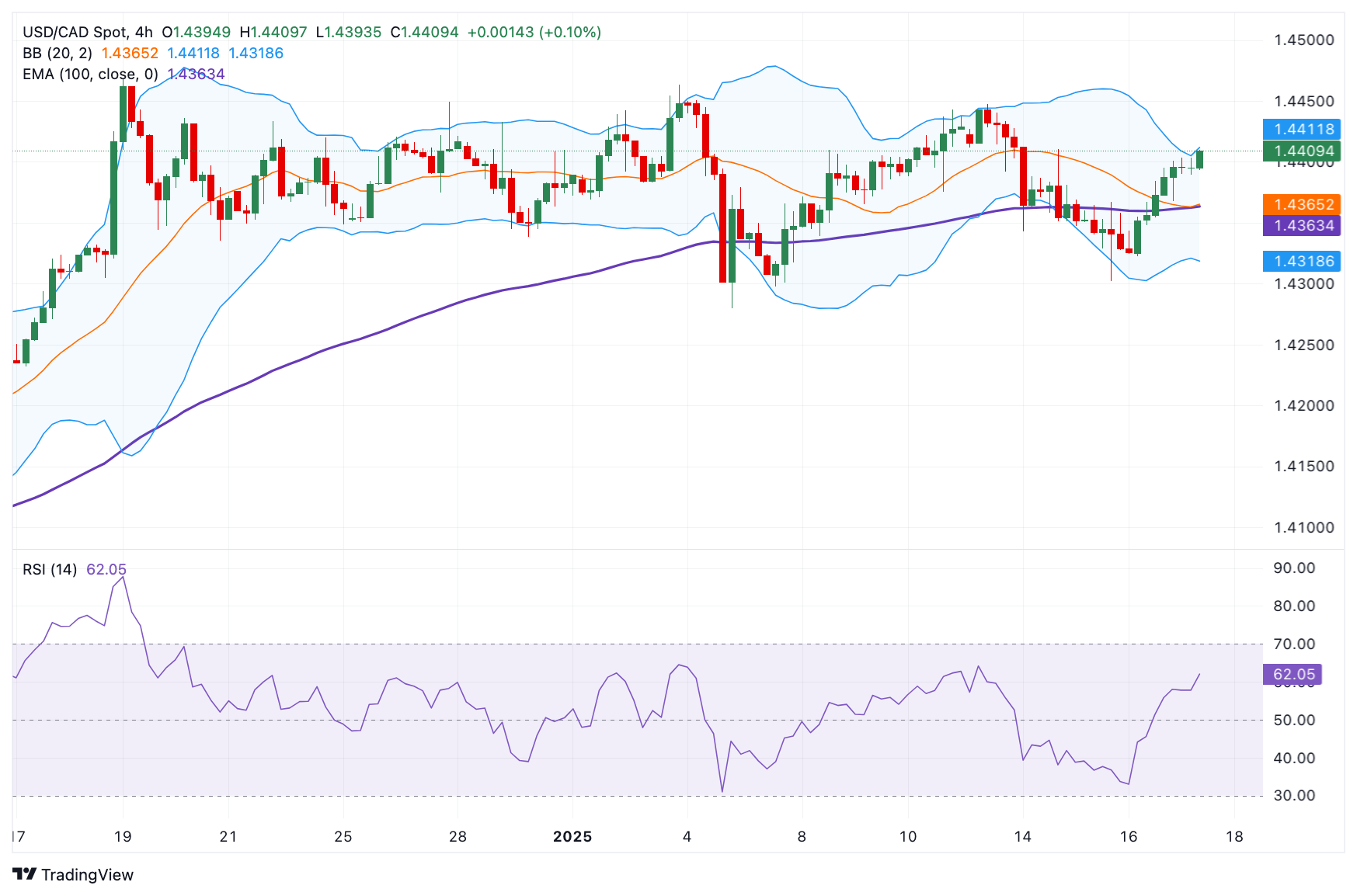USD/CAD Price Forecast: Extends recovery above 1.4400
- USD/CAD extends the rally to around 1.4405 in Friday’s early European session.
- The pair resumes its upside above the 100-period EMA with the bullish RSI indicator.
- The first resistance level to watch is 1.4410; the initial support level emerges at 1.4363.
The USD/CAD pair gains traction to near 1.4405 during the early European session on Friday. The recovery of the US Dollar (USD) broadly provides some support to the pair. Nonetheless, the rising bets that the US Federal Reserve (Fed) would reduce interest rates twice this year might cap the upside for the pair.
Technically, USD/CAD resumes its upside journey as the price holds the key 100-period Exponential Moving Average (EMA) on the 4-hour chart. The upward momentum is also supported by the Relative Strength Index (RSI), which is located above the midline near 61.50, suggesting further upside looks favorable in the near term.
The first upside barrier for the pair is seen at 1.4410, the upper boundary of the Bollinger Band. Sustained trading above the mentioned level could pave the way to 1.4447, the high of January 13. Further north, the next hurdle to watch is the 1.4500 psychological level.
On the flip side, the initial support level for USD/CAD emerges at 1.4363, the 100-period EMA. A breach of this level could see a drop to 1.4322, the low of January 16. The additional downside filter to watch is 1.4279, the low of January 6.
USD/CAD 4-hour chart
Canadian Dollar FAQs
The key factors driving the Canadian Dollar (CAD) are the level of interest rates set by the Bank of Canada (BoC), the price of Oil, Canada’s largest export, the health of its economy, inflation and the Trade Balance, which is the difference between the value of Canada’s exports versus its imports. Other factors include market sentiment – whether investors are taking on more risky assets (risk-on) or seeking safe-havens (risk-off) – with risk-on being CAD-positive. As its largest trading partner, the health of the US economy is also a key factor influencing the Canadian Dollar.
The Bank of Canada (BoC) has a significant influence on the Canadian Dollar by setting the level of interest rates that banks can lend to one another. This influences the level of interest rates for everyone. The main goal of the BoC is to maintain inflation at 1-3% by adjusting interest rates up or down. Relatively higher interest rates tend to be positive for the CAD. The Bank of Canada can also use quantitative easing and tightening to influence credit conditions, with the former CAD-negative and the latter CAD-positive.
The price of Oil is a key factor impacting the value of the Canadian Dollar. Petroleum is Canada’s biggest export, so Oil price tends to have an immediate impact on the CAD value. Generally, if Oil price rises CAD also goes up, as aggregate demand for the currency increases. The opposite is the case if the price of Oil falls. Higher Oil prices also tend to result in a greater likelihood of a positive Trade Balance, which is also supportive of the CAD.
While inflation had always traditionally been thought of as a negative factor for a currency since it lowers the value of money, the opposite has actually been the case in modern times with the relaxation of cross-border capital controls. Higher inflation tends to lead central banks to put up interest rates which attracts more capital inflows from global investors seeking a lucrative place to keep their money. This increases demand for the local currency, which in Canada’s case is the Canadian Dollar.
Macroeconomic data releases gauge the health of the economy and can have an impact on the Canadian Dollar. Indicators such as GDP, Manufacturing and Services PMIs, employment, and consumer sentiment surveys can all influence the direction of the CAD. A strong economy is good for the Canadian Dollar. Not only does it attract more foreign investment but it may encourage the Bank of Canada to put up interest rates, leading to a stronger currency. If economic data is weak, however, the CAD is likely to fall.



